Dear Friends:
We are delighted to welcome you to two exhibitions of original cartoon art by Bill Watterson and Richard Thompson at the Billy Ireland Cartoon Library & Museum, opening March 22, 2014. The shows will provide a unique opportunity to see—up-close—the original art of these two gifted cartoonists.

The exhibition will include the very first “Calvin & Hobbes” strip. November 18, 1985. © Bill Watterson – Used by permission of the artist. Bill Watterson Deposit Collection, The Billy Ireland Cartoon Library & Museum
Curator Jenny Robb recently chatted with Bill Watterson about comics and the upcoming exhibit:
Jenny Robb: Why did you choose to place your collection at The Ohio State University’s Billy Ireland Cartoon Library & Museum?
Bill Watterson: Long ago my friend Rich West recommended the library to me. I met Lucy Caswell and was much impressed with her vision and scholarly professionalism. Some years after I stopped the strip, I wanted to get my work into a more protective, permanent environment, so the choice was a no-brainer. And now of course the Billy Ireland Cartoon Library & Museum is even better. It’s a remarkable institution, and the fact that this fabulous resource is right in my home state is icing on the cake.
JR: The library and museum is focused on preserving and providing access to materials documenting the cartooning art form for public viewing and research. How do you feel this arrangement benefits the public?
BW: The library helps counteract the art world’s condescension to the “low art” of cartoons, and it protects work that would otherwise be scattered or lost. In making original work available for anyone to study, it also gives us access to our own history. You know, if you’re a painter, it’s simply taken for granted that you’ll spend a lot of time in museums studying great paintings, but if you’re a cartoonist, it used to be very hard to see an original cartoon drawing. When you see an original “Steve Canyon” daily strip—they’re gigantic—it’s an entirely different experience than seeing a newspaper or book reproduction. There is much to appreciate and learn about this wonderful art.
JR: It’s been almost 30 years since Calvin and Hobbes launched, and almost 20 since it ended. How did it feel to revisit the strip for this exhibition?
BW: Oh, it’s fairly weird. There’s a sort of jet lag when you time-travel to your own past.
JR: When conceiving of a new strip, did the words or images come first? Or, is it a hybrid process? Is the process fraught or does it flow?
BW: Most often I’d begin with the words. Generally, the writing underwent so many revisions that there was no point in drawing anything until the dialog was fully set. I could always visualize the pictures anyway. It was the writing that gave me fits.
JR: As newspaper readership—and, subsequently, production—declines, do you think there will be fewer opportunities for the average person to forge a lasting bond with a character the way that people did with Calvin and Hobbes?
BW: That would be my guess. I can’t really picture the average person going to the trouble of curating his own little comic section, much less reading a new and unfamiliar strip for months to build up a relationship with it. There’s so much other content available—instantly and all for free—that there’s no reason to stick around if you’re not immediately enthralled. We consume everything like potato chips now. In this environment, I suspect the cartoonist’s connection with readers is likely to be superficial and fleeting, unless he taps into some fervent special interest niche. And that audience, almost by definition, will be tiny. It’s a very different world from the days when everyone in America knew who Popeye, Dick Tracy or Charlie Brown was.
JR: How has the digital era and social media freed cartoon artists?
BW: Anyone can publish now, and there are no restrictions of taste, approach, or subject matter. The gatekeepers are gone, so the prospect for new and different voices is exciting. Or at least it will be if anyone reads them. And it will be even more exciting if anyone pays for them. It’s hard to charge admission without a gate.
JR: Richard Thompson’s work will be on display along with yours. What makes him a standout to you?
BW: Very few cartoonists do so much, so well. Richard is a wonderful writer and one of the rare ones who can write truly unique, hilarious characters. He’s drawn incisive caricatures, lavish illustrations, and one of the most beautiful comic strips I’ve ever seen. And just when you think it couldn’t be better, sometimes he paints the stuff. Richard has the extra-deluxe, jumbo-size skill set. It’s an inspiring body of work.

Illustration from “The Indispensible Calvin and Hobbes”, 1992. © Bill Watterson – Used by permission of the artist. Bill Watterson Deposit Collection, The Billy Ireland Cartoon Library & Museum
_____________________________________________________________________

Richard Thompson’s “Cul de Sac”, January 29, 2008 © Richard Thompson, collection of the artist – Used by permission of Richard Thompson
Exhibited along with Bill’s work is the immensely talented creator of Cul de Sac, Richard Thompson. Exhibition Curator Caitlin McGurk got the opportunity to chat with Richard:
Caitlin McGurk: What are your favorite comics currently being published, in the newspaper pages and beyond?
Richard Thompson: Pearls Before Swine, Frazz, and a few others. Currently the comics scene is so atomized, it’s hard to limit favorites to newspaper strips
CM: What is your take on how the digital era and social-media has affected cartoonists, and further more, what are your thoughts on the “death” of print?
RT: It’s sad and confusing.
CM: Tell us about your process with creating Cul de Sac. Were the characters speaking to you after a while, or were the storylines a struggle?
RT: It was frighteningly easy. The characters came alive and I lost control of them early on. It was like dictation. The plots were so tenuous it didn’t matter what direction they went in. I always thought of it as an organic process. I’d just stand back and let it grow.
CM: How much of Cul de Sac is based on your own memories of childhood, or your experiences with your family?
RT: A lot. Almost none of it is specific enough that you could point to a given situation and easily find its inspiration.
CM: What is the best advice that you could give a young cartoonist?
RT: Run.
Try everything. Comics are, as they say, blowing up. The chance for invention is great but the chance for moneymaking is small. Right now creators are pretty much screwed.
CM: Where did you derive your inspiration for Richard’s Poor Almanac, and were there other reasons to discontinue it beyond a focus on Cul de Sac?
RT: I’ve gotten several dream jobs. Richard’s Poor Almanac was one of them. Each cartoon was sui generis (a curse and a blessing). I ended it when it became clear it was suffering in relation to Cul de Sac. I couldn’t juggle both cartoons.
CM: Who or what were the biggest influences on you as a cartoonist?
RT: Any cartoonist whose name begins with an ‘S’: Sorel, Steadman, Steinberg, Sempe…I’m considering changing my name to “Sthompson.” Basically anybody who makes me want to draw. The list is endless.
CM: I understand that you and Bill Watterson have a close friendship. Can you tell us about the history between the two of you, and your thoughts on his work?
RT: I guess you could say that the whole world has a close friendship with Calvin and Hobbes (I know I do). I’d known Rich West, one of Bill’s closest friends, for years. Unknown to me, he sent Bill some of my old work and Bill liked it. God knows I admire his work and comic genius immensely, so getting approbation from him made my head swell noticeably. It was like receiving an ‘atta boy’ from Jesus Christ.
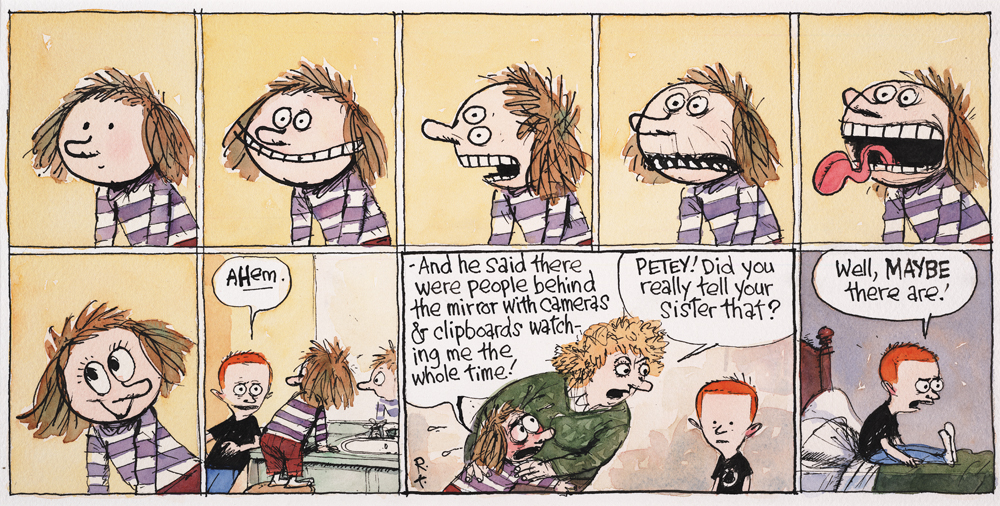
Richard Thompson’s “Cul de Sac”, November 4th, 2007 © Richard Thompson, collection of the artist – Used by permission of Richard Thompson
_____________________________________________________________________
Join us this summer for Exploring Calvin and Hobbes and The Irresistible Force Meets the Immovable Object: A Richard Thompson Retrospective: March 22 – August 3, 2014 / free / Tuesday-Sunday – 1pm to 5pm / Monday – Closed
As an added bonus, the Wexner Center for the Arts will be screening the documentary Dear Mr. Watterson at 4pm on Saturday, March 22, followed at 7pm by John Hubley at 100, a viewing of the incredible animation by the creator of Mr. Magoo.
And if you visit campus after May 17, take a short walk over to the Wexner Center for the Arts and check out famed cartoonist Daniel Clowes’ show: May 17 – Aug 3, 2014 / Tuesday-Sunday – visit wexarts.org for hours and admission fees. It is going to be the summer of cartoon art at Ohio State!
For reprint and image use permissions, please contact Jane Carroll at carroll.296@osu.edu.




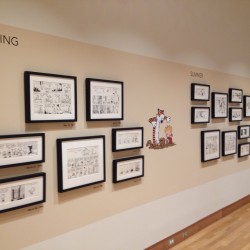
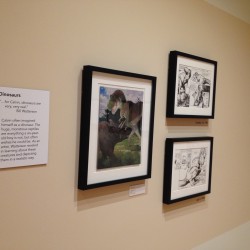

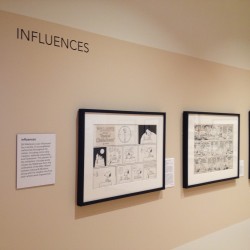

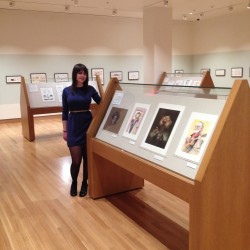
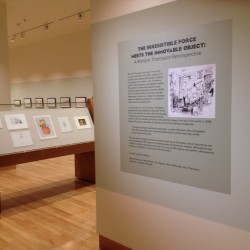
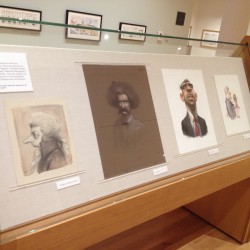









Recent Comments